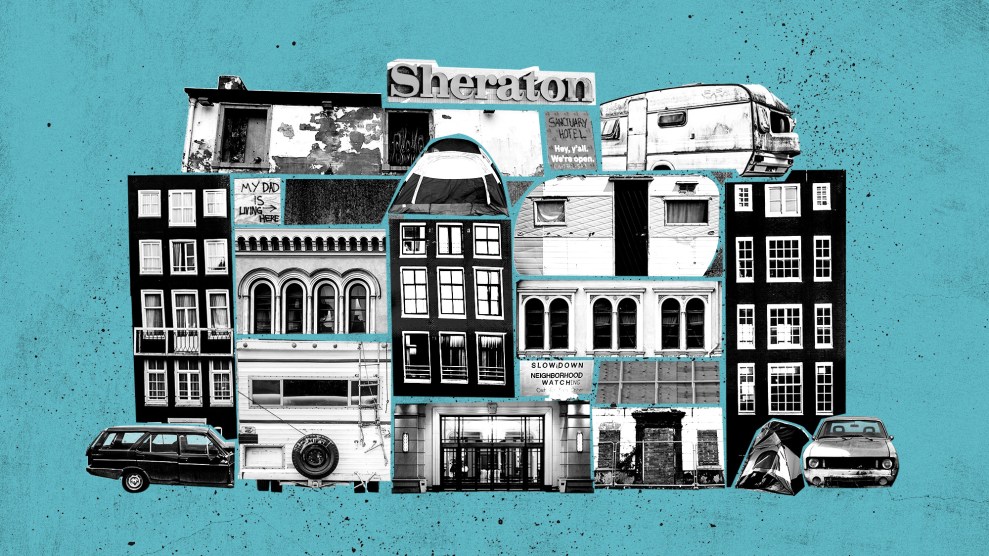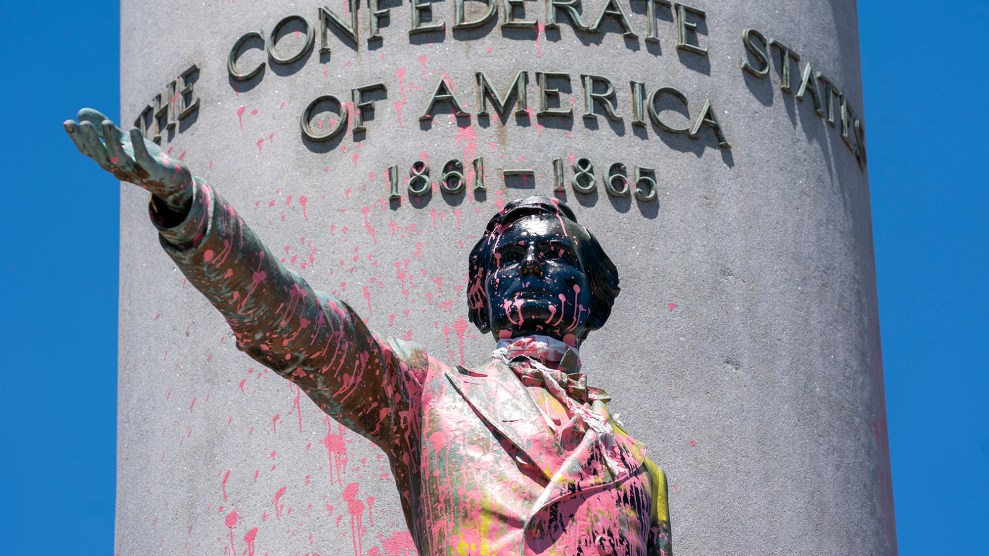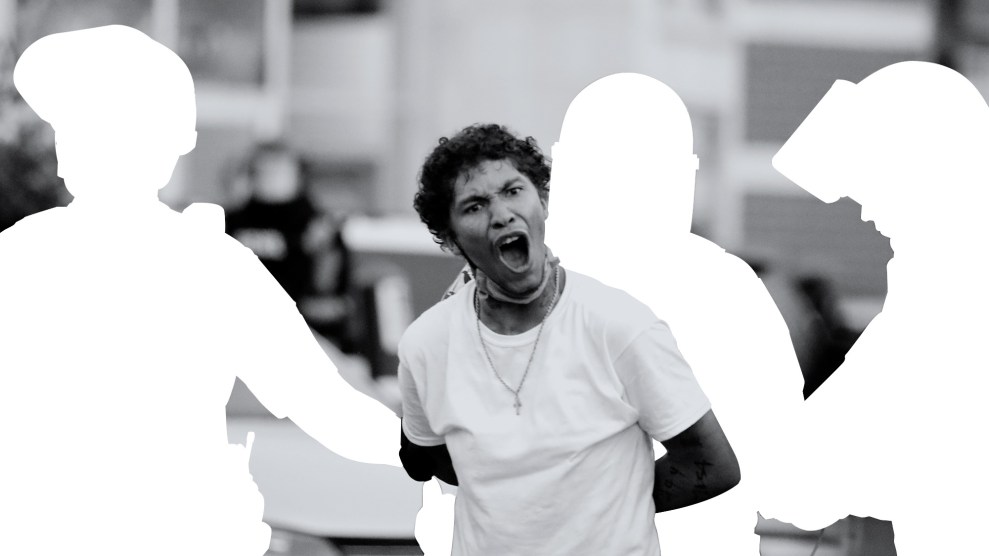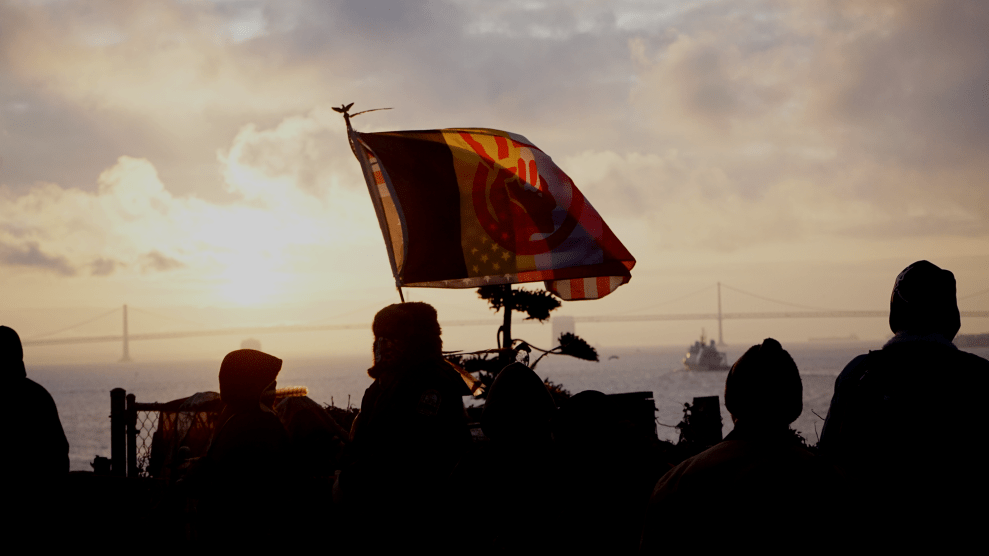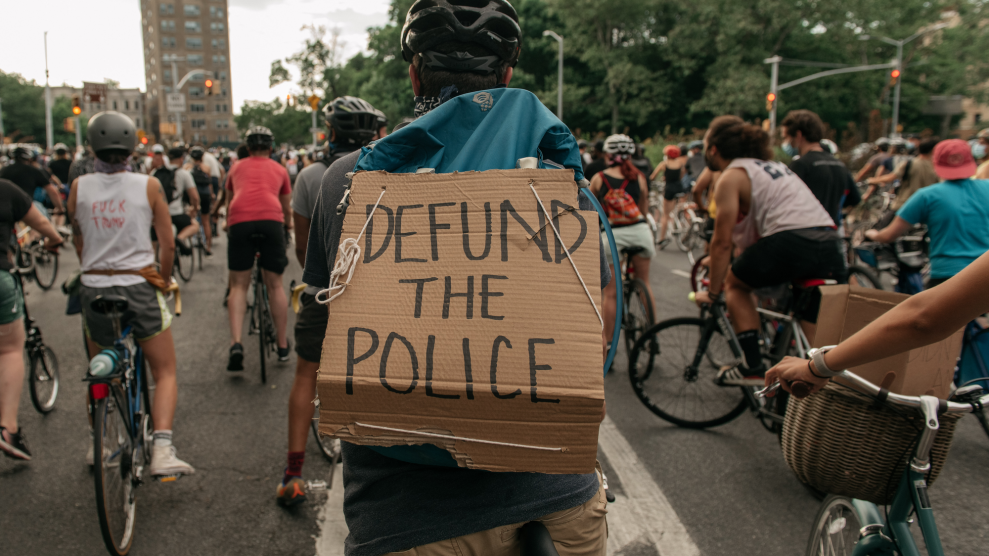
Cyclists in Brooklyn gather to ride in protest of systemic racism in policing after George Floyd was killed in Minneapolis.Scott Heins/Getty
Late one night at the end of May, as spray paint, fires, and looting reigned across Minneapolis, an Indigenous hip-hop artist named Tall Paul was roving the streets in a truck, looking for looters and arsonists. “It looked like that movie The Purge,” he says. “It was lawless.” Days before, Paul had joined the American Indian Movement Patrol, a group of Native Americans volunteering to maintain neighborhood safety and protect key buildings from destruction amid the rebellion.
Paul and the other volunteers on shift were on their way to check on the offices of the Leech Lake Band of Ojibwe when they saw four white teenagers looting a nearby liquor store. They stopped their truck and three of the teens fled, while Paul’s group caught up with the fourth. Soon his buddies returned, and all were made to lie on the ground so they couldn’t run away, then give their names and wait for a parent to come pick them up. The teens had driven 90 miles from suburban Wisconsin to take advantage of the chaos.
With a veto-proof majority of Minneapolis City Council members pledging to disband their police force, many wonder, “What comes next?” Activists from communities of color say the answer has been lurking under the city’s nose all along: neighborhood-based initiatives that protect property and prevent violence. In Minneapolis, those groups—AIM Patrol, as well as First Nations United, the Little Earth Patrol, and the NAACP’s Minnesota Freedom Riders, among others—are not new, but today they share a common vision: Without police, communities can maintain their own safety with less brutality and more accountability.
On Friday, the City Council voted unanimously to begin moving toward a “transformative new model” of public safety. “Safety is being able to decide who supports you,” says Arianna Nason of MPD150, a group that conducted a 150-year performance review of the Minneapolis Police Department. “It is absolutely imperative that we find community-based, community-controlled, bottom-up solutions.”
Native groups have a special place in the history of organizing, and of fighting police brutality, in Minneapolis. With more than 35,000 Native Americans in its greater metro area, the city has been a major urban hub for Indigenous people since the federal government began moving them off reservations in the 1950s. In 1968, fed up with unlawful arrests, police violence, and poverty, a group of Natives in Minneapolis launched the American Indian Movement, an organization dedicated to addressing chronic neglect and abuse. AIM became a national civil rights group, unifying tribes across the country and successfully challenging a federal “termination” policy that aimed to end the special status of Indigenous peoples by withdrawing federal services and aid.
From the beginning, members of AIM volunteered to patrol neighborhoods in order to document the Minneapolis Police Department’s rampant violence against Natives, which allegedly included coldblooded murders and rapes. As AIM co-founder Dennis Banks said at the time, police harassment was “an everyday fact for Indian peoples” in Minneapolis; the Black Panthers’ patrols had successfully reduced violence in their neighborhoods, “and we’re going to have to do the same.” Within a year, AIM Patrol claimed they’d seen 22 consecutive weeks without a Native being arrested, while in years prior they’d seen five or six Natives arrested per day. The Patrol has existed off and on ever since.
Mike Forcia, who is Anishinaabe and has worked with the American Indian Movement since its early days, revived AIM Patrol from its most recent hiatus in 2010 after witnessing EMTs roughly handle the dying body of an Ojibwe elder who’d been violently attacked (the death was never investigated). Along the way, he’s had his own run-ins with racist Minneapolis police, and received a $125,000 settlement from their department after officers who “misidentified him” beat him during an arrest in 1999. Forcia says that incident began when he witnessed a Minneapolis police officer holding a gun to a Native girl’s head.
Tall Paul, for his part, once saw a cop grope his mother during a traffic stop, and later watched police beat his older brother, then whisper that they’d kill him if he ever brought a lawsuit.
Though the current political moment focuses on violence against Black communities, police killings of Natives have long gone overlooked, in part because some departments don’t identify or track Indigenous victims. A CNN analysis of data from the Centers for Disease Control and Prevention found that Native Americans were slightly more likely than Black people to die at the hands of law enforcement between 1999 and 2015, though the rates are often neck-and-neck—and deeply intertwined.
In 2011, Derek Chauvin, the officer who killed George Floyd, was involved in the shooting of an Alaska Native named Leroy Martinez. (A witness claimed Martinez had surrendered his gun and had his hands in the air when he was shot.) Recognizing their common experience of police brutality, Native youth stood shoulder-to-shoulder with Black protesters throughout this year’s Minneapolis uprising.
For the past few years, AIM Patrol has been “under the radar,” says Forcia. His recruits walk the streets, deterring both police and intra-community violence by intervening or simply bearing witness to make accountability possible. Members can also be called upon to safely escort women, elders, or others who don’t feel safe moving through the neighborhood alone. Forcia has expanded the definition of Patrol duties to include cooking hot breakfasts for the unhoused and checking on overlooked neighbors.
Compared to the police, Forcia says AIM Patrol has “a more hands-on, personal approach” to safety. “You do it with kindness and generosity, but you always have to be alert.” Though the reality is that some communities prefer armed patrols, Forcia emphasizes that real peace arises when people’s needs are being met. He says that like cops, AIM Patrol members are “never really off duty,” but that usually means helping people move, offering rides, and sitting with those who might hurt themselves.
“If it’s a mental health crisis, I feel like an armed cop shouldn’t be coming, because they’re gonna come with a warrior mentality,” says Paul, who is Ojibwe and Oneida. “Mental health workers could be called. If there’s an overdose, a medic could be called. It shouldn’t just be ‘cops or nothing.'” But as of now, “people don’t know who to call besides 911.”
Paul and Forcia believe AIM Patrol could help fill that gap. Their group already helps with security for the city’s colorful Mayday Parade, and Forcia says he’s now in talks to support events in local parks, since the Minneapolis Park Board recently voted to cut ties with the police department.
Forcia says Mayor Jacob Frey exempted AIM Patrol from the city’s curfew so that they could protect their community. Meanwhile, City Council member Jeremiah Ellison, the son of Minnesota Attorney General Keith Ellison, was driving around with a pistol and fire extinguisher to protect his home neighborhood in north Minneapolis, along with the Minnesota Freedom Riders, a group of volunteers organized by a local NAACP chapter. These patrols, as well as many others, acted as a deterrent against burning and looting, specifically protecting Black- and Native-owned businesses and community centers, they say.
As my colleague Julia Lurie reported from Minneapolis:
Residential neighborhoods formed security teams…equipped with block leaders, text threads, and schedules for sitting out on stoops with fire extinguishers. I ran into these community security guards repeatedly as I walked home around midnight after reporting on a protest a week after Floyd’s death. From their stoops, they asked me who I was, and then if I needed help. One man, standing on the corner with a team on Hennepin Avenue, said he would walkie talkie his neighbors down the street so they would know to expect me.
As 92 percent of Minneapolis police officers live outside the city, Paul thinks it’s time for a localized approach to safety. “When it’s someone from the community, there’s accountability because everybody knows them,” he says. Unlike a police officer, “if I were to do something dirty or unjust to people I know, I would be held accountable.” Patrol members should “be on their feet, not in the car with a barrier between them and the people.”
Certain Black activists, Minneapolis officials, and experts have embraced these arguments. Grassroots organizations Reclaim the Block and Black Visions Collective hosted the historic rally where nine of the city’s 13 council members pledged to initiate a transition away from policing and toward “a transformative model for cultivating safety.” When making his pledge, council member Phillipe Cunningham argued that the city has “poured [money] into the police department” while other groups “have been doing this work for decades and not getting paid.” In a press release, Reclaim the Block and Black Visions Collective, which both advocate for police abolition, acknowledged that their movement had been “built alongside the presence and legacy” of AIM Patrol, whose members attended the event.
AIM Patrol could help replace the police “because it is supported by the community,” says Nason of MPD150. “I trust my relatives to take the right approach to my personal safety.”
Yet Nason acknowledges that this type of solution could still beget profiling, harassment, and killings in communities where racism is rampant: Trayvon Martin was killed by an overzealous neighborhood watch volunteer, and while police abolitionists say that certain situations should be handled by social workers instead of cops, the social work institution has its own racist tendencies. “Part of the work of abolition has to be shifting the mindset and culture that’s all around us,” says Nason. “We’re going to have to tackle that head-on with difficult conversations” about prejudice, gun laws, and more.
Forcia has long covered AIM Patrol expenses, such as patrol car repairs, out of his own pocket, or by selling T-shirts in the community. If Minneapolis were to divert some of its $189 million police budget to neighborhood groups like his, he could develop robust training programs, distribute information about gun laws and safety, and feed and clothe neighbors in need—because “why would you loot if you already have enough at home?” he asks.
He’d also like to restart violence prevention initiatives like the American Indian–Somali Friendship Committee, which began bringing the two communities together for children’s basketball games and potlucks in 2010. While the project had some success in reducing neighborhood tensions, it folded after just a few years when city funding was cut.
Riding the global wave of removing historically fraught monuments, Forcia on Wednesday led the charge to pull down a statue of Christopher Columbus that stood outside the Minnesota State Capitol. Even this is part of a larger vision to lift up local communities: He’d like to hold the state’s largest-ever powwow on the Capitol grounds (and he’s in talks with Lt. Governor Peggy Flanagan, who is also Anishinaabe, to make it happen). “We’d invite the Somali community, and the Aztecs and the Hmong and all of Minnesota, to get to know each other as brothers and sisters.”
Forcia believes that investing in intercultural exchange, along with education, housing, and food, can heal the wounds that beget violence. “We certainly are hoping,” he says. “We’ve seen things in the past two weeks that I never thought would happen. You got Nancy Pelosi kneeling, so many cops kneeling…now is the time, and we are who we have been waiting for.”
Correction, June 20, 2023: An earlier version of this story misstated the number of Native Americans in the Minneapolis metro area.


